|
|
|
Sort Order |
|
|
|
Items / Page
|
|
|
|
|
|
|
| Srl | Item |
| 1 |
ID:
132270
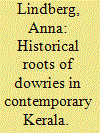

|
|
|
|
|
| Publication |
2014.
|
| Summary/Abstract |
Dowry payments from the family of the bride to that of the groom were rarely encountered in Kerala during the early twentieth century, but now are almost universal. Based on an examination of historical documents, including legislative debates, court cases, and reports, the way dowry was explained in the past is compared with the results of 200 contemporary interviews to determine its current rationale. Nowadays, making an obligatory payment for the maintenance of a wife, adherence to a social norm, and guaranteeing a woman's good treatment have displaced earlier arguments related to inheritance, status in the social hierarchy, or a woman's ability to provide for herself. Although several blurred traditions have been cited to account for dowries, they seem to have flourished in times of social inequity and uncertainty: the 1930s, 1970s, and 1990s. The emphasis on patriarchal nuclear families has created a mentality that a woman must pay for the privilege of being married and living securely.
|
|
|
|
|
|
|
|
|
|
|
|
|
|
|
|
| 2 |
ID:
151138
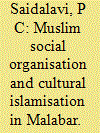

|
|
|
|
|
| Summary/Abstract |
This article calls for a re-evaluation of basic concepts
such as caste and status groups for making sense of the social
organisation of Muslims in Malabar. Muslim social groups, while
disseminating notions of egalitarian claims of Islam, rationalise
social divisions and discriminatory practices among themselves
largely in terms of Islamic juristic concepts of purity, knowledge,
piety and morality. Due to increasing Islamisation, these notions
have been reconstructed to sustain social divisions among Muslims.
Therefore, it is argued here that social divisions among Muslims in
Malabar today do not derive primarily from acculturative influences
of Hinduism. The article concludes that since sociological concepts
such as caste, ethnicity and status groups as used in South Asia have
failed to capture this Islamic cultural mediation, these phenomena
need to be further researched.
|
|
|
|
|
|
|
|
|
|
|
|
|
|
|
|
| 3 |
ID:
122436
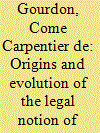

|
|
|
|
|
| Publication |
2013.
|
| Summary/Abstract |
In ancient and medieval western societies rights were prerogatives
enjoyed by the privileged minorities and by free men, as opposed to
slaves and bonded labour. By definition rights were thus unequally
distributed as males had more than women or children on whom within
their respective families, they had nearly absolute authority, just as
religious and land-owning (feudal) dignitaries held power over those
below them in the social hierarchy. Britain's coat of arms carries the
medieval motto: Dieu et mon droit, signifying "God and what I am
entitled to" by feudal or customary law or by divine right.
|
|
|
|
|
|
|
|
|
|
|
|
|
|
|
|
| 4 |
ID:
073595
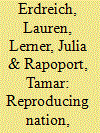

|
|
|
|
|
| Publication |
2005.
|
| Summary/Abstract |
This paper discusses the reproduction of hegemony and social hierarchy through education. It brings together two case studies of marginal groups at a university-Russian Jewish immigrants and Palestinian Israeli women-who make sense of their position in social hierarchies and power relations through constant interpretative work on the various dimensions of university knowledge. The article reveals how marginal actors' interpretations of knowledge simultaneously are guided by students' positioning vis-à-vis the dominant collective and also articulate and redesign positioning. The two groups redesign their marginalities vis-à-vis the Israeli-Jewish collective by transforming knowledge to identity. In so doing, these groups reproduce national borders of Israeli social hierarchy, while working to change the meaning of these borders for their group's positioning.
|
|
|
|
|
|
|
|
|
|
|
|
|
|
|
|
| 5 |
ID:
147835
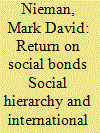

|
|
|
|
|
| Summary/Abstract |
This article takes a game-theoretic and latent variable approach to modeling the effect of international social hierarchies on conflict among states. I start with the premise that international states are social actors and are nested within informal social networks of friendly and conflictual relationships. Rather than lateral relationships among equals, networks among states tend to have a vertical or hierarchical structure. Although international hierarchical relationships may arise as a result of material power asymmetries, this article focuses on non-material asymmetries that stem from political legitimacy or policy innovation – a subject that has received less attention in scholarly research. I argue that, within these hierarchies, states adopt one of two roles – a dominant or a subordinate. Each resulting (dyadic) dominant–subordinate relationship is a social contract, in which the subordinate concedes some autonomy in exchange for the dominant’s protection. This social hierarchy affects the relationships among subordinates, as well as between a dominant and subordinates. The model predicts that a state’s degree of subordination reduces its probability of conflict initiation against other subordinates. Moreover, the decision to initiate conflict is influenced by the expectation that the dominant will intervene, which itself is affected by the target’s relative level of subordination to the dominant vis-à-vis the challenger. These predictions are supported by empirical analyses of the US hierarchy (1950–2000).
|
|
|
|
|
|
|
|
|
|
|
|
|
|
|
|
| 6 |
ID:
080623


|
|
|
|
|
| Publication |
2008.
|
| Summary/Abstract |
Ethnic Koreans in China have been widely recognized as a 'model minority' primarily for academic success. Using the data collected as part of a larger ethnographic research on Korean elementary school students, this paper examines how 27 Korean families construct meaning out of the model minority stereotype in the context of their lived experience in Northeast China. Research results indicate that Koreans constructed the multi-faceted nature of 'model minority' as a matter of cultural superiority and dual economic marginalization in the Chinese and South Korean mainstream societies, and valued education as a practical means to achieve economic upward mobility into the Chinese mainstream. This paper argues that the model minority stereotype with the cultural explanations for Korean success may reinforce the cultural deficiency argument about the academic failure of 'backward' minorities, silence the disadvantages suffered by Koreans in China's reform period and lead to no active intervention to remedy them
|
|
|
|
|
|
|
|
|
|
|
|
|
|
|
|
|
|
|
|
|